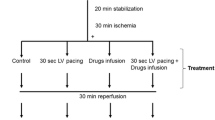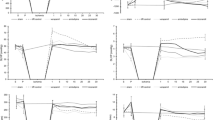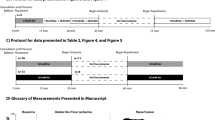Abstract
Objectives: We investigated the ability of diltiazem to prevent myocardial injury by assessing heart function and intracellular calcium concentrations before and after ischemia-reperfusion. Method: Isolated rat hearts underwent cardioplegia using the Langendorff perfusion model and were subjected to normothermic global ischemia for 60 minutes. The recovery rates for the heart function (heart rate, coronary flow, left ventricular systolic pressure) after reperfusion were monitored, and the intracellular Ca concentration was measured during ischemia and during the following reperfusion. Experimental groups were divided into three groups according to the diltiazem concentration used in the cardioplegic solution (potassium 20 mmol/l in Ringer's solution): (1) Group A: diltiazem 2.5 mg/l; (2) Group B: diltiazem 5 mg/l; and (3) Group C: no diltiazem. Results: Intracellular calcium concentration increased in all 3 groups during ischemia, but was significantly lower in Group B compared to either Group A or Group C. The heart function was significantly higher for Group A than for Group B or Group C. The hearts in Group B displayed markedly poor recovery in contractility and in heart rate. Conclusions: Generally, a decrease in intracellular Ca concentration improves the heart function during ischemia and after reperfusion. However, this study showed that some increase in intracellular Ca at the beginning of reperfusion assisted the contractility of rat heart.
Similar content being viewed by others
References
Hamm CW, Thandroyen FT, Opie LH. Protective effects on isolated hearts with developing infarction: slow channel blockade by diltiazem versus beta-adrenoceptor antagonism by metoprolol. Am J Cardiol 1982; 50: 857–63.
Chan WP, Bharadwaj B, Prasad K. Effects of diltiazem on the functional recovery of the myocardium at organ and cellular level during prolonged hypothermic ischemic cardiac arrest. Angiology 1990; 41: 702–14.
Nomura F, Matsuda H, Nakano S, Ohtani M, Takami H, Hirose H, et al. Enhancement of cardiac prostacyclin release during reperfusion after diltiazem supplemented potassium cardioplegia. J Cardiovasc Surg 1991; 32: 26–30.
Standeven JW, Jellinek M, Menz LJ, Kolata RJ, Barner HB. Cold blood potassium diltiazem cardioplegia. J Thorac Cardiovasc Surg 1984; 87: 201–12.
Christakis GT, Fremes SE, Weisel RD, Tittley JG, Mickle DA, Ivanov J, et al. Diltiazem cardioplegia. J Thorac Cardiovasc Surg 1986; 91: 647–61.
Melendez FJ, Gharagozloo F, Sun SC, Benfell K, Austin RE, Shemin RJ, et al. Effects of diltiazem cardioplegia on global function, segmental contractility, and the area of necrosis after acute coronary occlusion and surgical reperfusion. J Thorac Cardiovasc Surg 1988; 95: 613–7.
Allen BS, Okamoto F, Buckberg GD, Acar C, Partington M, Bugyi H, et al. Reperfusate composition: benefits of marked hypocalcemia and diltiazem on regional recovery. J Thorac Cardiovasc Surg 1986; 92: 564–72.
Sasaki A, Iwata M, Watanabe A, Kikuchi S, Inoue N, Yokoyama H, et al. Potential benefit of calcium antagonist (diltiazem) added to blood cardioplegia (Eng abstr). Jpn J Thorac Cardiovasc Surg 1988; 36: 508–20.
Inoue K. The evaluation of the myocardial protective effects of various cardioplegic solutions: the experimental studies by isolated working rat hearts. J Showa Med Assoc 1979; 39: 143–57.
Grynkeiwicz G, Poenie M, Tsien RY. A new generation of Ca2+ indicators with greatly improved fluorescence properties. J Bio Chem 1985; 260: 3440–50.
Katz AM, Reuter H. Cellular calcium and cardiac cell death. Am J Cardiol 1979; 44: 188–90.
Nayler WG. The role of calcium in the ischemic myocardium. Am J Pathol 1981; 102: 262–70.
Jennings RB, Reimer KA. Lethal myocardial ischemic injury. Am J Pathol 1981; 102: 241–55.
Walsh RA, Badke FR, O'Rourke RA. Differential effects of systemic and intracoronary calcium channel blocking agents on global and regional left ventricular function in conscious dogs. Am Heart J 1981; 102: 341–50.
Kashima T, Inoue K, Yokokawa H, Kume M, Takaba T, Hisamitu T. Recording of epicardial monophasic action potentials using a suction electrode to evaluate myocardial protection—as an additive effects of diltiazem on crystalloid cardioplegic solution. Jpn J Cardiovasc Surg 1992; 21: 41–8.
Author information
Authors and Affiliations
Rights and permissions
About this article
Cite this article
Inoue, K., Ando, S., Itagaki, T. et al. Intracellular calcium increasing at the beginning of reperfusion assists the early recovery of myocardial contractility after diltiazem cardioplegia. Jpn J Thorac Caridovasc Surg 51, 98–103 (2003). https://doi.org/10.1007/s11748-003-0080-x
Received:
Accepted:
Issue Date:
DOI: https://doi.org/10.1007/s11748-003-0080-x




